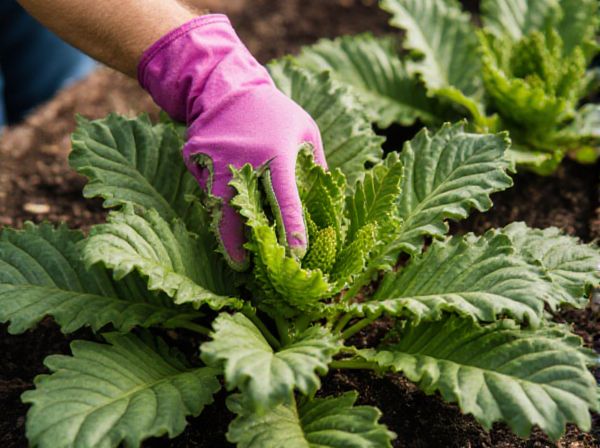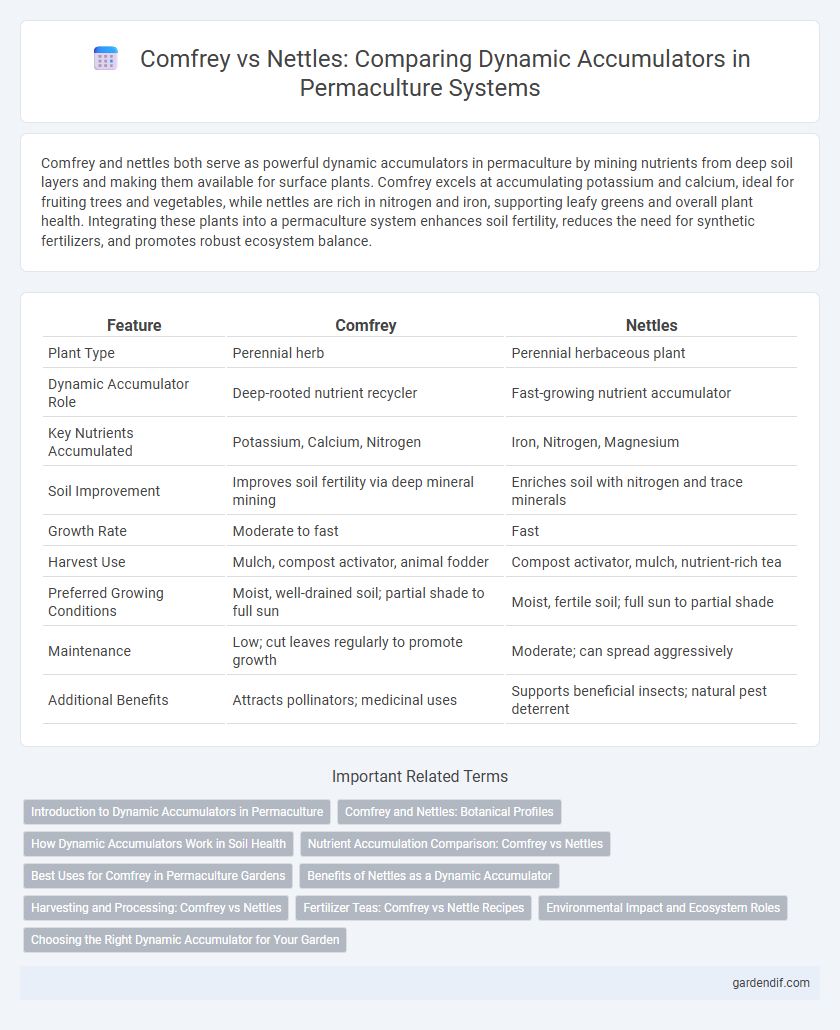
Comfrey vs Nettles (as Dynamic Accumulators) Illustration
Comfrey and nettles both serve as powerful dynamic accumulators in permaculture by mining nutrients from deep soil layers and making them available for surface plants. Comfrey excels at accumulating potassium and calcium, ideal for fruiting trees and vegetables, while nettles are rich in nitrogen and iron, supporting leafy greens and overall plant health. Integrating these plants into a permaculture system enhances soil fertility, reduces the need for synthetic fertilizers, and promotes robust ecosystem balance.
Table of Comparison
| Feature | Comfrey | Nettles |
|---|---|---|
| Plant Type | Perennial herb | Perennial herbaceous plant |
| Dynamic Accumulator Role | Deep-rooted nutrient recycler | Fast-growing nutrient accumulator |
| Key Nutrients Accumulated | Potassium, Calcium, Nitrogen | Iron, Nitrogen, Magnesium |
| Soil Improvement | Improves soil fertility via deep mineral mining | Enriches soil with nitrogen and trace minerals |
| Growth Rate | Moderate to fast | Fast |
| Harvest Use | Mulch, compost activator, animal fodder | Compost activator, mulch, nutrient-rich tea |
| Preferred Growing Conditions | Moist, well-drained soil; partial shade to full sun | Moist, fertile soil; full sun to partial shade |
| Maintenance | Low; cut leaves regularly to promote growth | Moderate; can spread aggressively |
| Additional Benefits | Attracts pollinators; medicinal uses | Supports beneficial insects; natural pest deterrent |
Introduction to Dynamic Accumulators in Permaculture
Dynamic accumulators in permaculture are plants that absorb and concentrate essential nutrients from the soil, making them valuable for improving soil fertility. Comfrey is renowned for its deep roots that mine potassium, calcium, and nitrogen, while nettles are rich in nitrogen and trace minerals, promoting vigorous plant growth when used as mulch or compost. Both plants enhance nutrient cycling and support sustainable gardening by replenishing soil nutrients efficiently.
Comfrey and Nettles: Botanical Profiles
Comfrey (Symphytum officinale) is a hardy perennial with large, hairy leaves and bell-shaped purple flowers, known for its deep taproot that mines nutrients like potassium, calcium, and phosphorus from subsoil layers. Nettles (Urtica dioica) are fast-growing herbaceous perennials with serrated leaves covered in stinging hairs, rich in nitrogen, iron, and trace minerals crucial for soil fertility. Both plants function as dynamic accumulators, enhancing soil health and providing valuable biomass for compost and mulch in permaculture systems.
How Dynamic Accumulators Work in Soil Health
Comfrey and nettles act as dynamic accumulators by mining essential nutrients such as potassium, calcium, and nitrogen from deep within the soil profile, making these nutrients available to surface plants. Their extensive root systems access minerals unavailable to shallow-rooted crops, which are then concentrated in their leaves and stems for decomposition or mulch use. This natural nutrient cycling enhances soil fertility, promotes microbial activity, and improves soil structure in permaculture systems.
Nutrient Accumulation Comparison: Comfrey vs Nettles
Comfrey accumulates high levels of potassium, calcium, and nitrogen, making it a powerful nutrient reservoir for permaculture gardens. Nettles are rich in nitrogen, iron, and magnesium, which support vigorous plant growth and improve soil fertility. Both dynamic accumulators enhance soil health, but comfrey offers broader nutrient diversity, while nettles excel in nitrogen fixation and mineral enrichment.
Best Uses for Comfrey in Permaculture Gardens
Comfrey excels as a dynamic accumulator by mining essential nutrients like potassium, calcium, and nitrogen from deep soil layers, enriching permaculture gardens without synthetic fertilizers. Its large, nutrient-dense leaves serve as excellent mulch and compost activators, accelerating soil fertility and plant growth. Planting comfrey near fruit trees and vegetable beds maximizes nutrient cycling and boosts overall garden productivity.
Benefits of Nettles as a Dynamic Accumulator
Nettles excel as dynamic accumulators by efficiently extracting essential nutrients like nitrogen, potassium, and calcium from deep soil layers, enriching the topsoil upon decomposition. Their dense foliage provides habitat for beneficial insects and can be used to create nutrient-rich compost teas that enhance plant growth. Additionally, nettles improve soil structure and support biodiversity, making them a vital component in sustainable permaculture systems.
Harvesting and Processing: Comfrey vs Nettles
Comfrey leaves can be harvested multiple times per growing season, with each cut allowing the plant to regrow quickly, making it ideal for sustained nutrient accumulation and compost activation. Nettles require careful handling during harvesting to avoid stings, and their nutrient-rich stems and leaves are best processed by drying or steeping in water to create potent liquid fertilizers. Both plants excel as dynamic accumulators, but comfrey offers higher biomass yield for mulching, while nettles provide quicker nutrient release through nutrient-dense liquid extracts.
Fertilizer Teas: Comfrey vs Nettle Recipes
Comfrey and nettles are both powerful dynamic accumulators used in permaculture for fertilizer teas, with comfrey rich in potassium and calcium, while nettles provide high levels of nitrogen and iron. Comfrey tea, made by fermenting its leaves in water for 2-3 weeks, boosts flowering and fruiting plants, whereas nettle tea, brewed over 24-48 hours, is ideal for leafy greens and overall plant vigor. Combining these teas or alternating their use optimizes nutrient profiles, enhancing soil fertility and plant health in organic gardening systems.
Environmental Impact and Ecosystem Roles
Comfrey and nettles serve crucial roles as dynamic accumulators in permaculture by enriching soil with essential nutrients; comfrey excels in accumulating potassium and calcium, improving soil fertility and structure, while nettles concentrate nitrogen and iron, promoting plant health and supporting beneficial insect populations. Both plants contribute to ecosystem balance by providing habitats for pollinators and natural pest predators, enhancing biodiversity and reducing the need for chemical inputs. Cultivating comfrey and nettles simultaneously optimizes nutrient cycling and supports resilient, sustainable agricultural systems with minimized environmental impact.
Choosing the Right Dynamic Accumulator for Your Garden
Comfrey and nettles are both powerful dynamic accumulators, with comfrey excelling in nutrient-rich leaf production, particularly potassium and calcium, while nettles are rich in nitrogen and trace minerals. Selecting the right dynamic accumulator depends on your garden's soil needs and specific plant requirements, as comfrey supports perennial systems and mulch production, whereas nettles promote soil fertility and attract beneficial insects. Integrating both plants can optimize nutrient cycling and enhance overall garden resilience in permaculture designs.
Comfrey vs Nettles (as Dynamic Accumulators) Infographic

 gardendif.com
gardendif.com